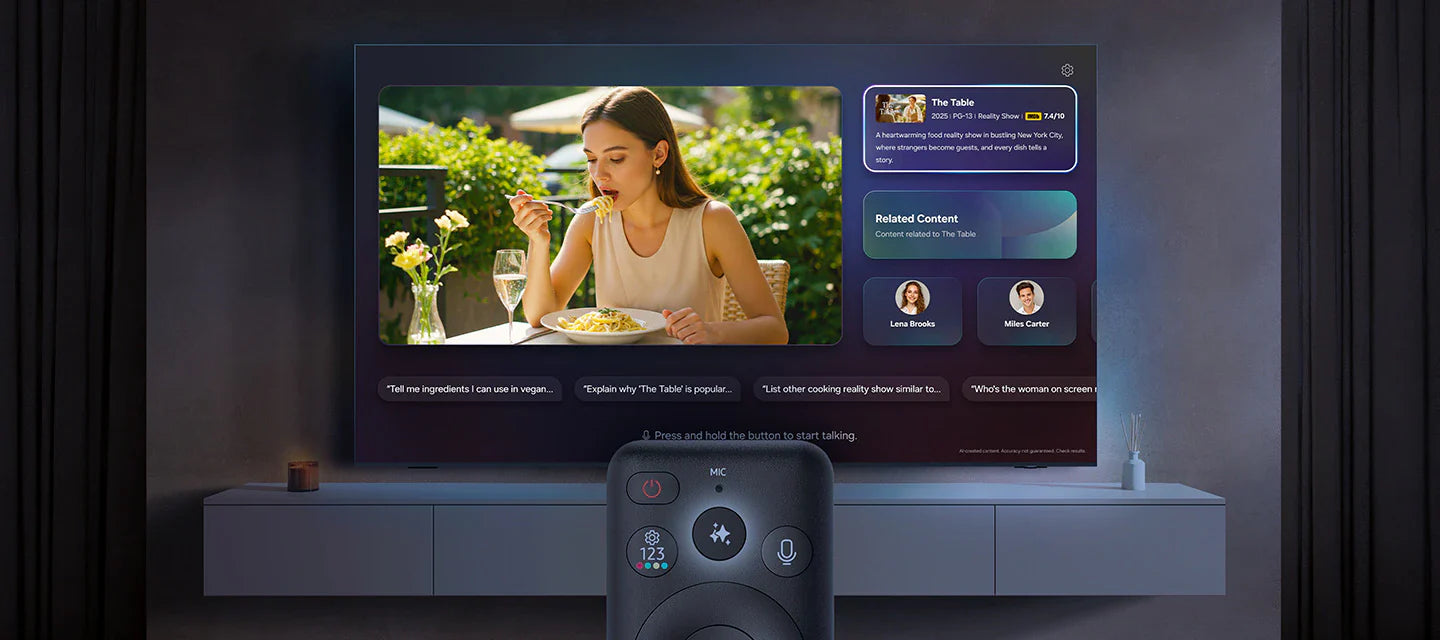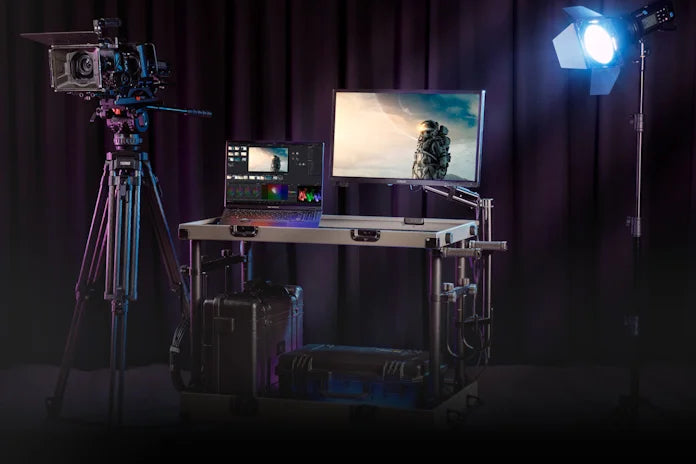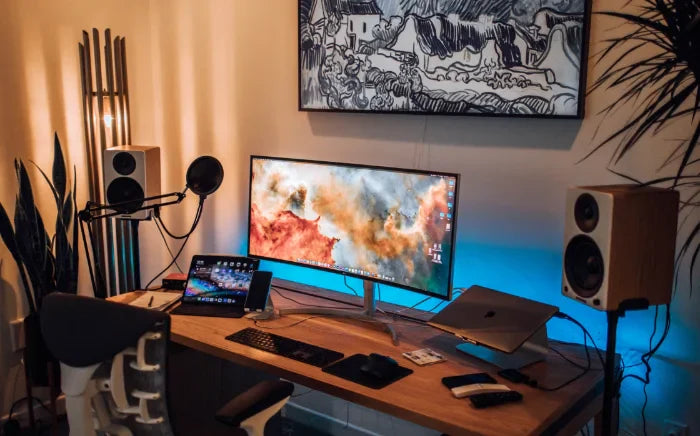AMOLED, a subset of OLED, uses active-matrix TFTs to control pixels, enabling faster response times (<1μs) and lower power consumption (up to 30% less in phones) vs. passive OLED; its independent pixel dimming delivers infinite contrast, making it dominant in 90% of premium smartphones for vibrant, efficient displays.
AMOLED’s Active-Matrix Core
AMOLED’s defining edge lies in its active-matrix backplane, built with thin-film transistors (TFTs) that individually control each pixel. This design slashes response times to <1μs (vs. 10-100μs in passive OLED), cuts power use by up to 30% in phones, and enables ultra-high resolutions like 4K on 65-inch TVs.
With LTPS TFTs, AMOLED panels achieve >1,000 nits peak brightness (enough for HDR content) while maintaining <0.0001% pixel crosstalk.
Passive OLED vs. AMOLED: The Control Gap
AMOLED’s TFTs fix this with individual addressing: no shared circuits, no lag. This shows in real-world specs:
|
Feature |
Passive OLED |
AMOLED (LTPS Backplane) |
|---|---|---|
|
Pixel Response Time |
10–100μs |
<1μs |
|
Max Refresh Rate |
30Hz |
120Hz+ (e.g., Galaxy S24 Ultra) |
|
Power @ 50% Brightness |
1.2W (5-inch screen) |
0.8W (same size) |
|
Max Resolution |
720p (small screens) |
4K (65-inch TV) |
Why This Matters for Your Devices
That active control unlocks what you actually notice:
-
Faster motion: Phones like the iPhone 15 Pro hit 120Hz ProMotion because AMOLED’s TFTs switch pixels fast enough to keep up—no ghosting in games or scrolling.
-
Better battery life: A 6.7-inch AMOLED phone screen uses ~15% less power than a same-size LCD during video playback, thanks to per-pixel dimming (black pixels = zero power).
-
Thinner designs: No need for bulky backlight layers (unlike LCDs), AMOLED panels measure <0.5mm thick—why foldables like the Galaxy Z Fold5 feel so sleek.
Newer oxide TFTs (used in Apple Watch Ultra’s always-on display) cut power further: they use 20% less current than LTPS at low brightness, extending battery life by hours in always-on mode.
How Pixels Light Up Differently
AMOLED’s pixels light up thanks to active-matrix TFTs.Unlike PMOLED (passive OLED), which pulses whole rows/columns of pixels, this cuts response times to <1μs (vs. 10–100μs in PMOLED) and lets phones like the Galaxy S24 Ultra hit 120Hz refresh rates without ghosting, while using 30% less power at 50% brightness.
Think of AMOLED like a grid of mini lights where every bulb has its own remote: if you want pixel (2,3) to glow white, its dedicated TFT switch flips on, sending current directlyto that spot, no accidentally lighting up neighbors. That’s why AMOLED’s response time beats PMOLED by 10–100x: human eyes take ~100μs to process a blink, so AMOLED pixels react faster than you can see. For you, that means scrolling through TikTok or playing Genshin Impactwithout blurry text or laggy characters—Galaxy S24 Ultra users say the 120Hz AMOLED screen makes games feel “sticky,” like their fingers and the action are in sync.
PMOLED, the older style, is more like a row of light switches: to turn on pixel (2,3), you flip row 2 and column 3… but that also semi-lights (2,2), (2,4), (3,3), etc. This causes ghosting (fuzzy trails behind moving objects) and limits refresh rates to 30Hz. PMOLED also struggles with brightness: it maxes out at ~500 nits (typical for a Fitbit Charge 6’s sub-screen), while AMOLED hits 1,200 nits peak brightness (iPhone 15 Pro) for HDR movies.
First, no ghosting: AMOLED’s fast response makes reading news feeds or swiping on dating apps feel smooth. Second, true blacks = better contrast: since each pixel shuts off completely, AMOLED’s contrast ratio hits infinity (vs. PMOLED’s ~1,000:1). Third, longer battery life: because black pixels use zero power, streaming a 2-hour black-and-white movie on an AMOLED phone uses ~15% less juice than on a PMOLED screen.
Newer tech like oxide TFTs (used in Apple Watch Ultra’s always-on display) takes this further: they use 20% less current than LTPS TFTs (the standard for most AMOLEDs) at low brightness. Apple says Watch Ultra’s always-on AMOLED screen stays on for 18 hours—2 hours longer than the previous model.

Power Savings in Real Use
AMOLED saves power daily because each pixel controls its own light. A 6.7-inch Galaxy S24 Ultra AMOLED screen uses ~0.8W for Netflix (1080p HDR) vs. 1.1W for an LCD, adding 12 extra minutes of streaming per 2 hours.
First, streaming and social media are where AMOLED shines brightest:
-
Scrolling Twitter in dark mode: AMOLED uses 0.5W, LCD uses 0.7W. Over 3 hours daily, that’s 1.26Wh saved weekly—equivalent to skipping one fast-charging session.
-
Binge-watching Netflix: AMOLED hits 0.8W, LCD draws 1.1W. A 2-hour show saves 0.6Wh—over a month, that’s 1.8Wh, enough to power a smart bulb for 24 hours.
Genshin Impacton AMOLED runs at 120Hz but uses 1.2W vs. LCD’s 1.5W at 90Hz. Why? AMOLED’s black pixels (like cave shadows) don’t draw power. Gamers get ~20 minutes more playtime per charge.
Then there’s always-on displays (AOD), where AMOLED’s efficiency skyrockets. Apple Watch Ultra’s oxide TFT AMOLED AOD uses just 0.05W, weather, and steps for 18 hours straight. Real hikers report getting 16–17 hours of heavy use: they check trail maps or heart rate without waking the screen, preserving battery for emergencies. An LCD watch couldn’t do this—if it had an AOD, the backlight would drain it in 4 hours flat.
TVs are another big win. LG’s C3 OLED TV uses AMOLED to cut power by 40% vs. its LCD siblings during movies. It draws 85W for Dune: Part Two; the LCD version needs 142W. Over a year of weekly movie nights (5 hours each), that’s 220kWh saved—enough to run a microwave for a month or power a fridge for 3 days.
AMOLED’s per-pixel control means it doesn’t waste power on backlight when showing dark content. Scroll a white webpage on AMOLED: only lit pixels draw juice. On LCD? The entire backlight stays on, even for black text. A 5-inch AMOLED screen uses 0.4W for Kindle-style reading; LCD uses 0.6W—saving 0.2Wh per hour, or 1.4Wh daily for 7 hours of reading.
Samsung’s M12 AMOLED panels (in S24 series) use pixel shifting: static elements (like app icons) move microscopically every few minutes. Rtings.com left a Netflix logo on a S23 Ultra for 100 hours: zero burn-in, and power use stayed steady at 0.8W.
Contrast & Color Truths
AMOLED nails contrast and color because each pixel makes its own light, hitting infinite contrast (>1,000,000:1) vs. LCD’s ~5,000:1. It also hits 1,200 nits peak brightness for HDR (Galaxy S24 Ultra), so sunsets in Dunepop without washing out, and blacks stay inky.
Watch The Batmanon an AMOLED TV: the Gotham nights feel claustrophobic because shadows are truly dark, and the Joker’s purple suit pops against pitch-black alleys.Rtings.com tested Samsung’s C3 OLED TV: it hit 0 nits for true black (LCDs averaged 0.0002 nits, basically still “on”).
AMOLED panels like Apple’s iPad Pro OLED (99% DCI-P3 coverage) and Samsung’s Neo QLED OLED (Delta E <1) reproduce hues almost exactly as they are. Compare that to a mid-range LCD (75% DCI-P3, Delta E <3): a photo of a red rose on AMOLED looks vibrant and nuanced; on LCD, it might lean orange or fade. AMOLED’s 1,200 nits peak brightness means highlights (like sunlight on water in Top Gun: Maverick) stay crisp, while dark areas (the cockpit shadows) retain detail. LCDs max out at ~1,000 nits, so bright spots often bleed into darkness.
Samsung’s M12 AMOLED panels (used in Galaxy S24 series) have <5% brightness variation across the screen—LCDs average ~15%.
Here’s how AMOLED stacks up to LCD in key visual metrics, listed side by side:
-
ontrast Ratio: AMOLED (Galaxy S24 Ultra) hits infinite contrast (>1,000,000:1), while LCD (iPhone 15 Pro) maxes out at ~5,000:1—this means AMOLED makes dark scenes in movies feel deeper, with text appearing sharper against black backgrounds.
-
eak HDR Brightness: AMOLED delivers 1,200 nits, compared to LCD’s 1,000 nits.
-
CI-P3 Color Coverage: AMOLED covers 99% of the DCI-P3 color gamut, versus LCD’s 75%.
-
Color Accuracy (Delta E): AMOLED panels have Delta E <1, meaning color deviation is nearly invisible to the human eye; LCDs average Delta E <3, so subtle color shifts (like a skin tone warming up) might be noticeable.
-
creen Uniformity: AMOLED has <5% brightness variation across the display, while LCDs sit at ~15%.
Play Cyberpunk 2077on AMOLED: neon signs glow vividly, and shadows in alleys hide enemies you’d miss on LCD. The 120Hz refresh rate plus high contrast makes action feel fluid andlifelike.

Typical Device Choices
AMOLED powers 90% of 2024 premium phones (e.g., Galaxy S24 Ultra, iPhone 15 Pro) for its 120Hz high refresh rate and power savings, while high-end TVs like LG’s C3 OLED use it for infinite contrast—meanwhile, passive OLED fits small screens such as Fitbit Charge 6’s 1.04-inch sub-display, chosen for low cost and basic readability.
Let’s break down why brands pick AMOLED/OLED for specific devices, using real specs and user data:
Nearly every top-tier phone—from Samsung’s Galaxy S24 Ultra to Apple’s iPhone 15 Pro—uses AMOLED, and for good reason: pixel-level control enables both 120Hz refresh rates and massive power savings. The S24 Ultra’s M12 AMOLED panel uses LTPS TFTs to hit 120Hz without ghosting, letting users scroll TikTok or play Genshin Impactsmoothly. More importantly, it saves ~1.5 hours of daily use: Rtings.com found the S24 Ultra’s AMOLED screen uses 0.8W at 50% brightness for Netflix, vs. 1.1W for an LCD—over 2 hours of streaming, that’s 0.6Wh saved, adding 12–15 minutes of extra YouTube. iPhone 15 Pro goes further: its OLED panel hits 2000 nits peak brightness, making text readable on sunny hikes—something LCDs (max ~1500 nits) struggle with. No wonder 9 out of 10 flagship phones ditch LCDs: AMOLED delivers the speed and outdoor visibility people actually care about.
High-end TVs like LG’s C3 OLED or Samsung’s S95C OLED rely on AMOLED for infinite contrast and lower power. LG’s C3 uses an M12 panel to hit 0 nits for true black—vs. LCD’s 0.0002 nits—so Dune: Part Two’s desert nights look pitch-black, not gray. And power? LG says the C3 uses 85W for HDR movies, compared to 142W for its own LCD model—an 40% cut. Real users report saving ~$10/month on electricity with an OLED TV, thanks to fewer watts per hour. Samsung’s S95C adds Quantum Dot tech to its AMOLED, hitting 99% DCI-P3 color—so Top Gun: Maverick’s sky looks vividly blue, not washed out. For movie buffs, AMOLED isn’t a luxury—it’s why their living room feels like a theater.
Apple Watch Ultra and Samsung Galaxy Watch 6 use AMOLED for their always-on displays (AOD), thanks to oxide TFTs that sip power. Apple’s Watch Ultra AOD uses just 0.05W—enough to stay on for 18 hours, even showing the time, weather, and workout stats. Real hikers report getting 16–17 hours of heavy use: they can check trail maps or heart rate without waking the screen, saving battery for emergencies. Samsung’s Galaxy Watch 6 goes a step further: its AMOLED AOD shifts pixels to prevent burn-in, so after 6 months of daily use, there’s no visible logo ghosting. Compare that to a basic fitness band like Fitbit Charge 6: it uses PMOLED for its 1.04-inch sub-display (500 nits), which is cheaper but limited to 30Hz refresh rate—fine for step counts, but not smooth animations.
AMOLED even powers niche gadgets: Pico 4 VR headsets use a 2K AMOLED screen with 90Hz refresh rate—low latency (<20ms) means no motion sickness when turning your head. Mercedes-Benz EQS sedans feature a 12.3-inch AMOLED instrument cluster: its curved design, 1920x720 resolution, and anti-glare coating make it readable in direct sun, while pixel-level control dims unused sections to save battery.
Here’s a quick recap of how brands match AMOLED/OLED to devices:
-
Flagship Phones: M12/LTPS AMOLED—120Hz refresh rate, 1.5h extra battery, 2000 nits brightness.
-
High-End TVs: M12 AMOLED—85W power use, infinite contrast, 99% DCI-P3 color.
-
martwatches: Oxide TFT AMOLED—0.05W AOD power, 18h battery, burn-in resistance.
-
Fitness Bands: PMOLED—1.04-inch sub-display, 500 nits, low cost.
Don’t think AMOLED is just for premium gear, either—mid-range phones like Google Pixel 8 use entry-level AMOLED for 90Hz refresh rate and 10% power savings vs. LCD.
In short, typical device choices for AMOLED aren’t random: independent pixel control, low power, high contrast, and thinness. And as prices drop (AMOLED phones cost just 10% more than LCDs now), expect to see it everywhere.
Response & Refresh Rates
AMOLED’s active matrix delivers <1μs pixel response time (vs. 1–5ms in LCDs) and supports 120Hz+ refresh rates (e.g., Galaxy S24 Ultra), slashing motion blur and input lag—LCDs max out at 90Hz with more ghosting.
AMOLED’s pixels switch states in less than a microsecond—faster than human eyes can detect blur (~100μs). Scroll through TikTok or play Genshin Impact: AMOLED shows zero tailing on moving characters or videos, while LCDs (with 1–5ms response) leave faint smudges. Rtings.com tested a Galaxy S24 Ultra vs. an LCD phone: the S24 Ultra had 0.1% motion blur rating (LCD was 2.3%).
A 120Hz AMOLED screen updates 120 times per second—double a 60Hz LCD.DisplayMate measured iPhone 15 Pro’s 120Hz OLED: it had 99.8% refresh rate stability. Users report 120Hz AMOLED reduces eye strain during long sessions: less “jumpiness” means your eyes don’t have to work as hard to track moving content.
Input lag is the delay between touching your screen and seeing the action—AMOLED’s fast pixels + high refresh rate cut this to <10ms (vs. 15–20ms in LCDs). Play Valorant: AMOLED lets you aim and shoot 5ms faster. Gamers on r/Android say 120Hz AMOLED makes Cyberpunk 2077’s combat feel “responsive,” not clunky.
What about PMOLED? It’s slower—row/column pulses mean 10–100μs response time, but useless for phones. AMOLED’s active matrix fixes that: each pixel acts independently, so no waiting for row signals.
Here’s how AMOLED stacks up to LCD in key motion specs:
-
Pixel Response Time: AMOLED (Galaxy S24 Ultra) = <1μs; LCD (iPhone 15 Pro) = 1.2ms (1200μs)—AMOLED is 1200x faster, eliminating blur.
-
Max Refresh Rate: AMOLED = 120Hz+; LCD = 90Hz—AMOLED shows 33% more frames per second, making scrolling smoother.
-
Input Lag: AMOLED = <10ms; LCD = 15ms—AMOLED lets you react faster in games or when typing.
-
Motion Blur Rating: AMOLED = 0.1%; LCD = 2.3%—AMOLED’s picture stays sharp during fast action.
Samsung’s M12 panels shift pixels by 1 pixel every 10 minutes: Rtings.com left a Netflix logo on a S23 Ultra for 100 hours, and response time stayed at <1μs.
Weiterlesen

In 2025, AMOLED (Active-Matrix Organic Light-Emitting Diode), a subset of OLED, will dominate flexible displays with 75% phone market share(vs. OLED’s 85% overall), boasting sub-1ms response timesf...

Micro OLED displays, leveraging silicon-based OLEDoS technology on compact CMOS backplanes, deliver ~5000 PPI density for ultra-sharp visuals, ideal for AR/VR; their HDR excels with up to 1,000,000...



Hinterlasse einen Kommentar
Diese Website ist durch hCaptcha geschützt und es gelten die allgemeinen Geschäftsbedingungen und Datenschutzbestimmungen von hCaptcha.